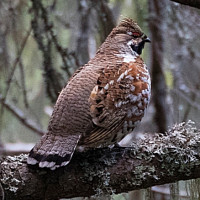Descrição
The mountains of the Prespa Lakes National Park are more than 2300 metres high, while the lakes lie at the lowest point of the park, at 850 m a.s.l. The Mikri Prespa is shallow, less than ten metres and reeds-fringed, while the northern Megali Prespa is 55 m deep, cold and rich in fishes.
275 bird species were recorded in the national park, 160 of them breeding in it. One tenth of the global population of Pelicano-crespo breed here and can be observed from March to early October. In 2022, the bird flu killed more than 60% of the breeding pelicans at Lesser Prespa Lake, causing the greatest ecological disaster on record for Greek wildlife. The Pelicano-vulgar arrive later, in April-May, and were mostly spared.
The “Prespa Walking Guide” further says that species found here to breed or probably breed at the very edge of their European breeding range are Merganso-grande (Megali Prespa – relic and isolated population), Galinha-do-mato (Mt. Sfika), Melro-das-rochas, Toutinegra-gavião, Felosa-unicolor, Felosa-palustre and the Escrevedeira-de-cabeça-preta.
There are 172 species of butterflies recorded within the national park, 24 species of bats, plus the Beech Marten (which I saw only as a road-kill), Otter, Wild Cat, Badger, Wild Boar, Grey Wolf and the European Brown Bear, among others.
Detalhes
Acesso
If you are flying to Greece, it is more convenient to fly to Thessaloniki and drive two and a half hours west along the Odos Egnatia motorway, exit for Kastoria (a lovely town – if your time allows, do have a lunch by the lakeside) and continue north to Prespa Lakes. Zoom in on the map and click on the "P" (parking) sign for driving directions.
Terreno e Habitat
Floresta , Terras húmidas , Montanha , Lago , Árvores e arbustos dispersos , CampinaCondições
Montanhoso , Montanhoso , RochosoCaminho circular
Nãoé útil um telescópio?
Pode ser útilBoa temporada de observação de aves
Primavera , Verão , OutonoMelhor hora para visitar
PrimaveraRota
Estrada pavimentada , Estrada não pavimentadaCaminho dificil
Caminhada médiaAcessível por
Carro , Bicicleta , PéAbrigo/plataforma deobservação de aves
NãoInformação extra
To be properly explored, Prespa Lakes require at least two days or, better, three, even four days.
The most detailed description of the wider area is to be found in the Birdwatching in Northern Greece (2023) by Steve Mills.
The best topographic maps of the area, accompanied by a walking guide describing 14 nature tours in full detail, can be obtained at the Society for the Protection of Prespa, online or at their HQ in the village of Laimos (Lemos) during working hours; go left at the square with a small park, then right after the bridge.
Ligações
- eBird list
- Prespa Lakes National Park, Greece: the largest Dalmatian Pelican colony in the world
- Birding in Greece – Travel Guide to birdwatching sites in Greece (2014, pdf download) by Vlachos, Trigou & Stavrakas



